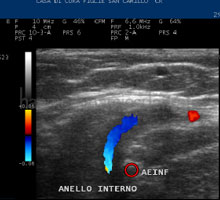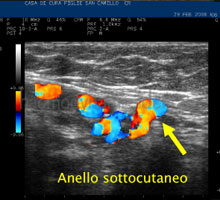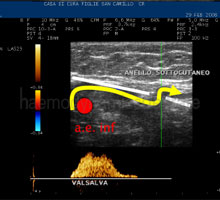Varicose veins of pelvic origin in the lower limbs 
Women’s varicose veins in the lower limbs have the peculiar characteristic of originating from inguinal pelvic points instead of classical saphenous or perforating escape points.
There are well-defined anatomical points of passage of venous collectors that normally drain into the pelvis: blood that comes from the legs, the perineum, the inguinal, the crural and the pubic area.
For men, there is a very low incidence of varicose veins and a much lower percentage of men than women form varicose veins in the lower limbs from a pelvic escape point. The only cause for men is the feeding of the pampiniform plexus in the case of varicocele.
As far as women’s health, the presence of varicose veins in the lower limbs due to pelvic escape points must not be associated with the constant presence of pelvic varicocele and should not be confused with pelvic congestion syndrome. Actually, the pelvic varicocele is a very frequent event in women and it is very often asymptomatic and not associated with varicose veins in the lower limbs.
Symptoms of pelvic congestion syndrome: symptoms appear in the form of constant, lasting and intense pelvic pain with monthly phases; due to the significant increase of constant pressure in the pelvic veins.
Causes of pelvic congestion syndrome: they may be a result of an obstruction or compression of the left renal vein with forced drainage of the kidney into the left ovarian vein and then into the pelvis.
Further consequence of a devalvulation of the ovarian vein with reflux from the left renal vein in the ovarian vein.
Attention: this syndrome may actually be associated with leaks from the pelvis toward the lower limbs, even if this possibility has a very negligible percentage incidence compared with all the escapes of the pelvic origin responsible for varicose veins in the lower limbs.
WHAT KIND OF DIAGNOSTICS?
A haemodynamic evaluation.
Solution: identify and treat the cause of the pressure excess. The haemodynamic correction in varicose veins of the lower limbs aims to normalise blood pressure inside the veins, through the identification and treatment of escape points, that is to say feeding points of venous hypertension.
Point P: posterior labial veins run under the skin of the back perineum and cross the valvular fascia in order to enter the venus plexuxes that drain into the pelvic circle. These veins are normally equipped with a valve that prevents reverse flow, i.e. from the plexus vulvar interior toward the subcutis.
After a pregnancy:
- for reasons of hormonal modification of the connective tissues
- pelvic venous hypertension
- growing compression of the uterus
these valves can fail permanently, with the formation of an escape point capable of generating varicose veins in the lower limbs.
Posterior labial veins are generally of concern. Only under exceptional circumstances there may there be an intermediate perineal escape point in addition to the classic perineal and posterior point P , and there may also be an anterior clitoral escape point.


Point I: perfect ultrasound view of the venous plexus of the round ligament that enters the inguinal canal lateral to the inferior epigastric vessels through the internal inguinal ring and runs into the inguinal canal. After, it emerges in the subcutaneous inguinal ring through the subcutaneous inguinal canal
The venous plexus of the round ligament connects the utero- ovarian venous plexuxes, with the sapheno-femoral junction and accounts for the possible formation of homo or contralateral or bilateral varicose veins of the lower limbs, starting from the pelvic reflux.










